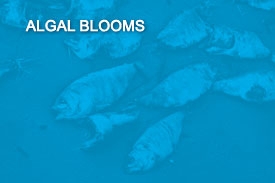Home
»
News
»
Narratives of One Health In Action
Algal Blooms
11/21/2011
"Red tides" affect the ecosystem including plants, animals and people
 “Red tide” is a colloquial term referring to a natural phenomenon known as a harmful algal bloom or HAB. Red tides, which are not always red in color, affect marine ecosystems throughout the world. The most conspicuous effects of red tides are the associated wildlife mortalities among marine and coastal species of fish, birds, marine mammals and other organisms. It is not uncommon to find thousands of dead fish following a harmful algal bloom.
“Red tide” is a colloquial term referring to a natural phenomenon known as a harmful algal bloom or HAB. Red tides, which are not always red in color, affect marine ecosystems throughout the world. The most conspicuous effects of red tides are the associated wildlife mortalities among marine and coastal species of fish, birds, marine mammals and other organisms. It is not uncommon to find thousands of dead fish following a harmful algal bloom.
The causes of red tides are unclear. Sometimes they are due to natural marine events, such as coastal upwelling of nutrients, inputs of iron rich sand from the Sahara desert, and temperature changes from El Niño events. In other cases they result from human activities, such as inputs of nutrients from municipalities or agricultural runoff. Impacts from red tides include human illness and mortality following consumption of contaminated seafood. Oysters and other shellfish can accumulate red tide toxins in their tissues. Eating shellfish containing red tide toxins may result in a serious illness, neurotoxic shellfish poisoning (NSP). State management programs are responsible for monitoring the concentration of the toxins in shellfish and closing shellfish beds for harvest if the levels rise above dangerous limits. Substantial economic losses can occur when marine harvesting becomes unsafe.
Although human health impacts are of prime importance, another societal concern is the massive mortalities of wild animals that are caused by HABs. Animal mortality events, such as fish kills, bird kills, or strandings of manatees and whales, have enormous impacts on local communities. More than half of the unusual marine mortality events are now associated with HABs. Sea lion mortalities are now almost annual events along the southern California coastline, and many of these have been linked to the algal toxins passed through the food web. Along the coast of Florida red tides most often are due to blooms of the marine algae Karenia brevis which produces a potent neurotoxin. In 1996, 150 manatees died in Florida from these algal toxins. In 2003, 107 bottlenose dolphins were found dead together with hundreds of fish and marine invertebrates along the Florida Panhandle—victims of a harmful algal bloom. In 1991 more than 100 pelicans and cormorants were found dead or suffering from unusual neurological symptoms in Monterey Bay, California due to a bloom of the diatom Pseudonitzschia australis, which produces a toxic acid. The toxin was transmitted to the seabirds via Northern anchovies. The deaths of 19 humpback whales near the Georges Bank in the Gulf of Maine is another such event associated with algal toxins. In freshwater systems, the impacts extend to birds and possibly alligators and other animals.





 “Red tide” is a colloquial term referring to a natural phenomenon known as a harmful algal bloom or HAB. Red tides, which are not always red in color, affect marine ecosystems throughout the world. The most conspicuous effects of red tides are the associated wildlife mortalities among marine and coastal species of fish, birds, marine mammals and other organisms. It is not uncommon to find thousands of dead fish following a harmful algal bloom.
“Red tide” is a colloquial term referring to a natural phenomenon known as a harmful algal bloom or HAB. Red tides, which are not always red in color, affect marine ecosystems throughout the world. The most conspicuous effects of red tides are the associated wildlife mortalities among marine and coastal species of fish, birds, marine mammals and other organisms. It is not uncommon to find thousands of dead fish following a harmful algal bloom.